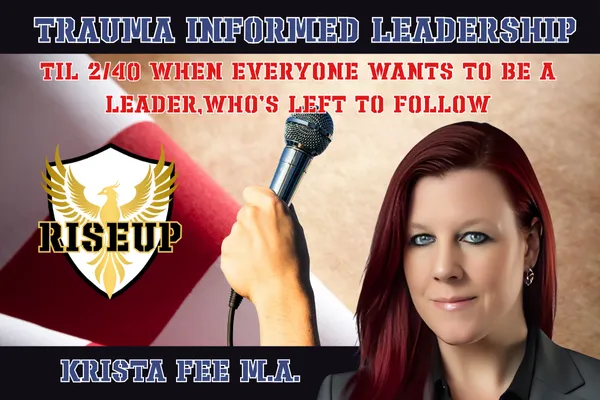
When Everyone Wants to Be a Leader, Who's Left to Follow
When Everyone Wants to Be a Leader, Who’s Left to Follow?
Leadership. Everyone wants it. Everyone claims it. Scroll through social media and you’ll see endless bios that say “leader.” Corporations run “emerging leader” programs. Conferences overflow with “leadership summits.”
But here’s the paradox: if everyone wants to be a leader, who’s left to follow?
This isn’t just semantics. It’s a critical question for organizations, movements, and communities operating in today’s world. Because leadership isn’t a solo act—it only exists in relationship to followership. Without followers, you don’t have leadership. You have noise.
The Fireline: Why Followership Matters
A wildland firefighter once told me, “We don’t need more chiefs—we need people who can hold the line.”
On the fireline, flames don’t care about rank. Survival depends on trust. The incident commander may make decisions, but the crew survives only if people can follow steadily, consistently, and with discipline.
If everyone tries to lead—shouting over one another, running in different directions—the whole crew burns.
The same is true for organizations, families, and communities. Leadership without followership is chaos.
Leadership Is Relational
We often envision leaders as solitary visionaries. But real leadership is always relational. People only follow when they feel safe—when their nervous system senses, this person sees further than I do, and they’re carrying weight with me.
Trauma-informed leadership makes this explicit. It’s not about demanding authority; it’s about cultivating trust. Without trust, teams destabilize, communities fracture, and nervous systems remain stuck in a state of fight-or-flight.
Leadership without followership isn’t leadership at all.
The Neuroscience of Why We Follow
Our brains are wired to seek safety in groups. Evolution has taught us that hierarchy and belonging are essential for survival.
When a leader shows calm presence and consistent responsibility, the amygdala relaxes. People can think clearly, make decisions, and act together.
When a leader is unpredictable or self-serving, cortisol spikes. People withdraw, splinter, or resist.
The science is clear: people don’t follow titles. They follow safety.
History’s Warnings
We’ve seen it again and again:
Armies collapse, not from enemy fire, but because soldiers lost trust in their leaders.
Social movements crumble because charismatic figures demanded loyalty without building credibility.
Leadership without followership is like a house built on sand—it may look strong, but the first storm will bring it down.
The Social Media “Leader”
Today’s digital world multiplies the problem. Everyone with a platform is suddenly a “leader.” Health leaders. Business leaders. Mindset leaders. But here’s the truth: visibility is not the same as credibility.
When everyone leads for the sake of being seen, we don’t build movements—we build noise. Performance may attract attention, but it doesn’t hold people together in crisis.
Trauma-informed leadership flips the script: you don’t lead because you post. You lead because people trust you enough to follow.
Learning to Follow
In my own journey, I had to face this paradox. Early on, I thought leadership meant always being out front, always having the answers, always setting the pace. But over time, real life taught me something else: sometimes the bravest act of leadership is knowing when to follow.
When someone else is better positioned or better resourced, following isn’t weakness—it’s wisdom. It says, the mission matters more than my ego.
And when we allow ourselves to follow in those moments, we multiply trust, not diminish it.
The Shadow Side: Ego and Trauma in Leadership
Unhealed leaders often confuse control with influence. They can’t tolerate following because it feels like weakness. They can’t step aside because it feels like failure.
But insecure leadership creates insecurity everywhere it touches. Teams mirror the dysregulation of the leader. Communities feel unsafe. Movements collapse under the weight of ego.
Trauma-informed leaders do the opposite. They regulate themselves so they don’t project fear onto the people they serve. And in that steadiness, trust grows.
Four Practices That Cultivate Followership
If leadership is relational, then the question becomes: how do we build it?
Clarity of Mission – People follow when they know where you’re going. Ambiguity breeds fear. Clarity calms.
Consistency of Presence – Show up the same way in calm and chaos. Consistency builds trust more deeply than charisma ever can.
Shared Responsibility – Don’t hoard weight. Invite others to carry it with you. Respect creates stability.
Humility to Follow – Model by example that following isn’t failure—it’s wisdom. It multiplies the mission.
Reflection Questions
Do I invite followership, or do I demand it?
How do I treat those who walk behind me—not because they’re weak, but because they trust me to see further?
Am I willing to follow when the mission is best served by someone else leading?
Final Thought
Leadership without followership is just noise. Leadership with followership is music. And when it’s trauma-informed, that music becomes the heartbeat of a movement.
If you’ve been chasing leadership for the sake of visibility, pause. Ask instead: am I creating the safety, trust, and clarity that allow others to follow? Because that’s where true leadership lives.
✨ Want to go deeper?
Book a call with Krista to see how trauma-informed leadership can transform your leadership or schedule your organization’s custom training series.
👉https://calendly.com/riseupphoenix/compass
